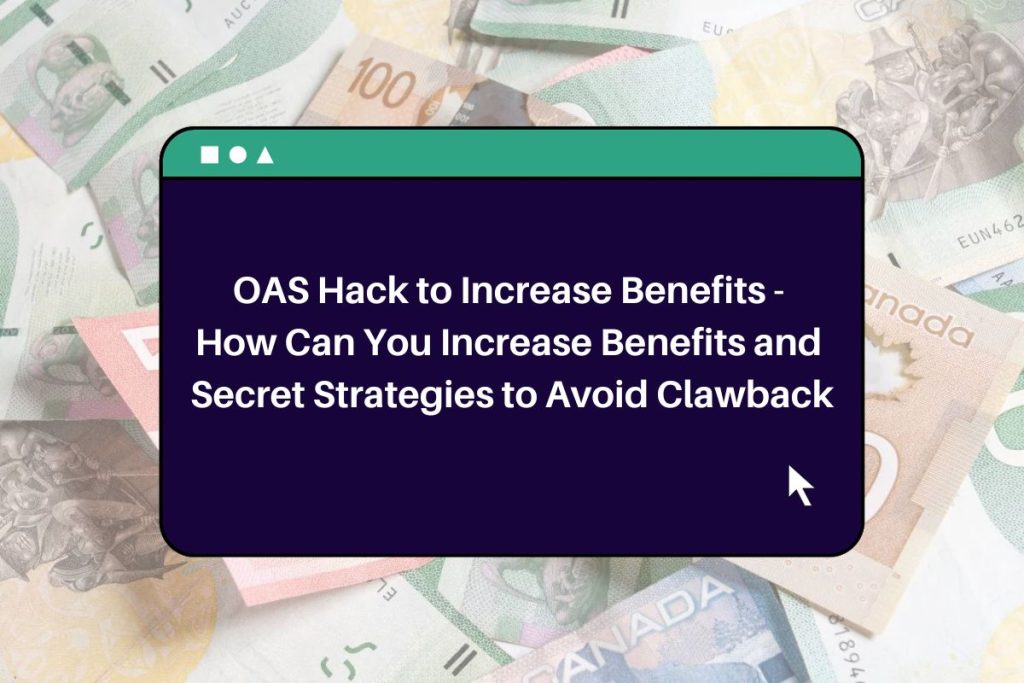When your net yearly income exceeds the CAD 81,761 minimum income level, you may be subject to an Old Age Security (OAS) clawback, often known as the OAS pension recovery tax. Depending on your level of retirement income, the tax may be a little sum or a large amount. It is calculated as 15% of the difference between your actual income and the threshold amount. So, how you Avoid OAS Clawback?
There are a few tactics that might assist you in planning ahead and reducing the amount of clawback. Here, i have covered the OAS Hack to Increase Benefits, and Secret Strategies To reduce OAS clawbacks. In order to qualify for Old Age Security (OAS), an individual must have been a citizen or permanent resident of Canada for at least 40 years after turning 18 and it is a personal benefit that is unaffected by a partner, family, or spouse.
What is OAS Clawback?
The majority of Canadians are qualified to receive Old Age Security (OAS), a sort of government pension, upon retirement. The OAS pension is funded by general government income but benefits from OAS also include a clawback. This is formally referred to as the OAS Recovery Tax and the purpose of the OAS benefit clawback is to lessen this benefit for retirees with greater incomes.
Once you earn more than CAD 86,912 in 2023 taxable income, the government begins to reduce your OAS amount. If you are required to pay the recovery tax depends on your existing worldwide taxable income. If so, a deduction will be made from your monthly OAS checks the following year.
OAS Hack to Increase Benefits and Avoid Clawback
In retirement, Canadians have access to many forms of income so they can lead there life. Individuals who worked during their adult life are eligible to receive CPP retirement benefits as early as age 60 since they made contributions to the program. Those who get income from job or self-employment are also eligible to make contributions to a registered retirement savings plan (RRSP).
The percentage of Canadians who can anticipate getting benefits from an employer-sponsored pension plan is steadily declining. OAS is an individual benefit, thus your family’s income has no bearing on it; instead, it is refunded based on your individual taxable income. For every dollar that an individual’s salary exceeds the threshold, OAS payments are cut by 15%.

Secret Strategies to reduce OAS clawbacks
- Delaying OAS Payments: You can minimize your taxable income and possibly even prevent the clawback by delaying the commencement of your OAS payments.
- Increasing Contributions to the TFSA: Making contributions to your TFSA is a great method to earn money that is tax free. Withdrawals from TFSA accounts minimize the clawback because they are not taxable income. They can also help you reduce your total income.
- Pension dividing: To reduce your total taxable income, if you have a spouse or common-law partner, you may want to think about dividing qualifying pension income. By doing this, the effect of the OAS clawback may be lessened.
- Strategic Asset Sales: You can lower your income and lessen the clawback by selling sizable assets before you turn 65. However, before making any large asset acquisition, it’s imperative to take prospective tax effects into account.
- Assess Your Revenue Sources: Income from unregistered investments is subject to a varied tax. For instance, dividends are grossed up to 138% before taxes, interest on GICs and savings accounts is completely taxable, while only 50% of capital gains are included in taxable income.
- Take out your RRSP before turning 65: You can disclose the majority of your RRSP income if you withdraw your funds before the age of 65, which may cause you to fall below the OAS clawback level.
- Using leverage to lower your earnings: You can reduce your income if you have borrowed money to make investment income by deducting the interest from the loan. While I would advise against taking on debt in order to implement this method, if you have already done so, be sure to deduct the interest income.
- Sell your investments before receiving benefits from OAS: Together with dividends, capital gains are one of the revenue streams that are taken into account in the computations. Consider selling off your equities before the year you turn 65 if you want to reduce your income for the years you’ll be receiving OAS.
- Restrict the amount of dividends you receive: Because dividend income is taxed at a lower rate than interest income and, to a lesser extent, capital gains, it is seen as tax efficient. The issue with dividend income is that in order to use the dividend tax credit and receive a tax benefit, there must be a dividend gross-up. As the grossed-up income is applied, dividend income might actually bring you closer to the OAS clawback level. When choosing investments that yield dividend income, use caution if your income is near the OAS line.
| Our Homepage | Matricbseb.com |
- About the Author
- My Recent Posts
